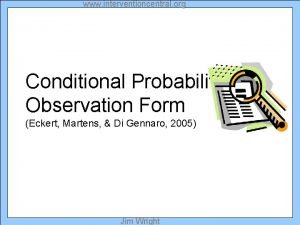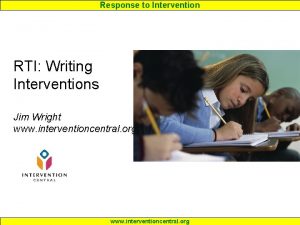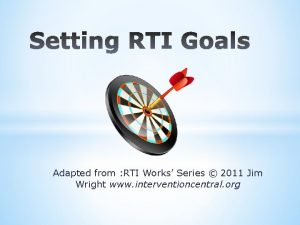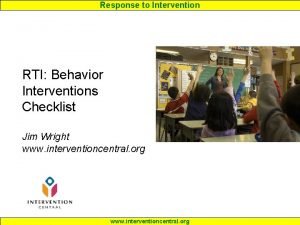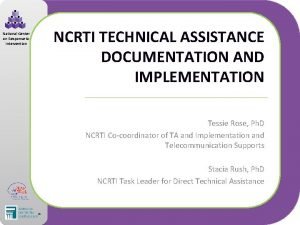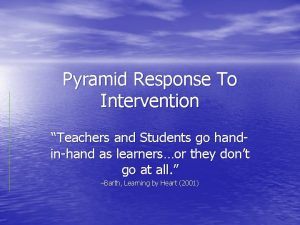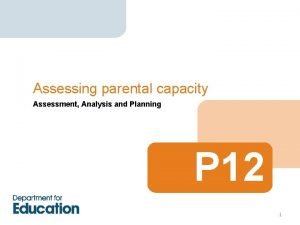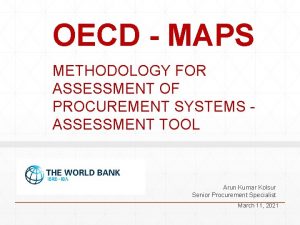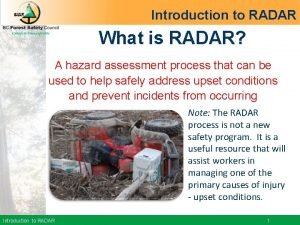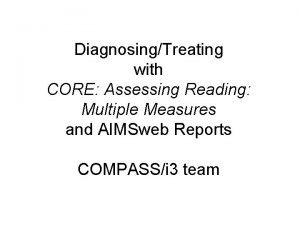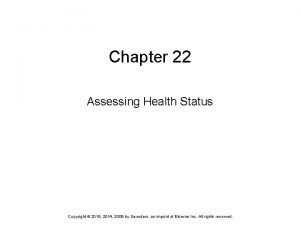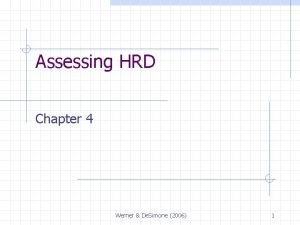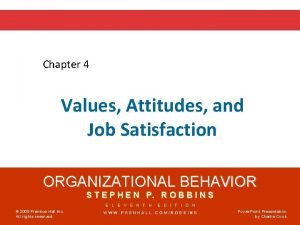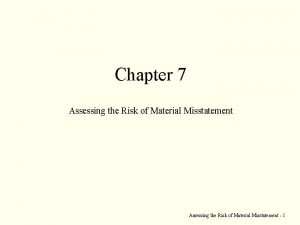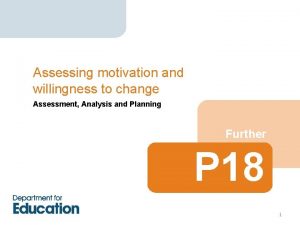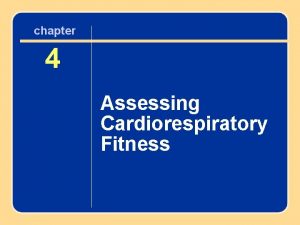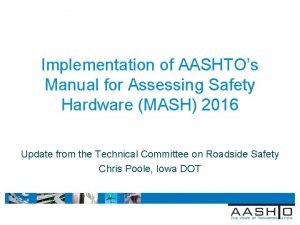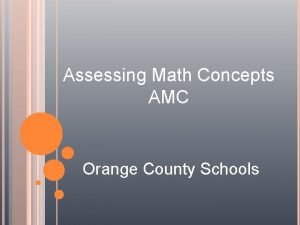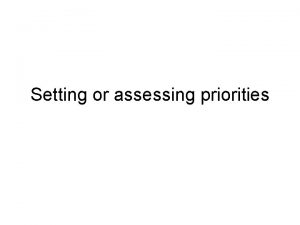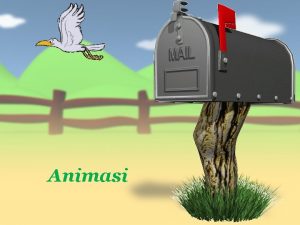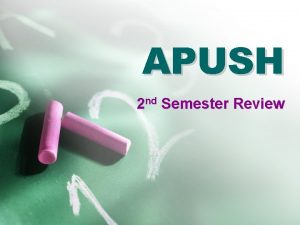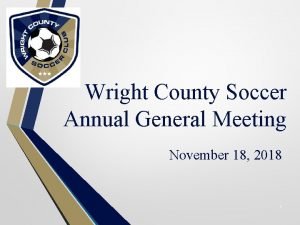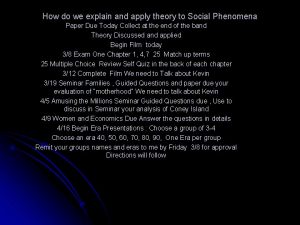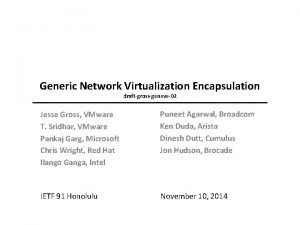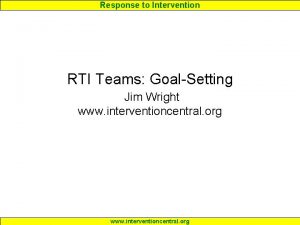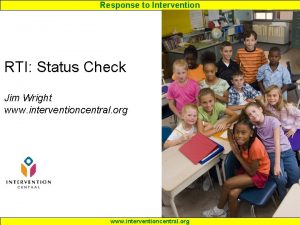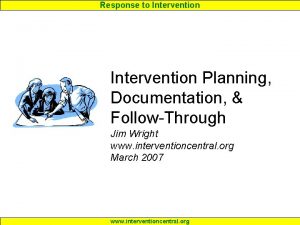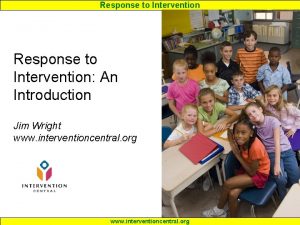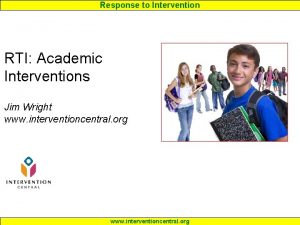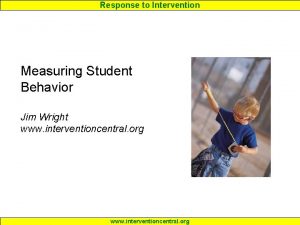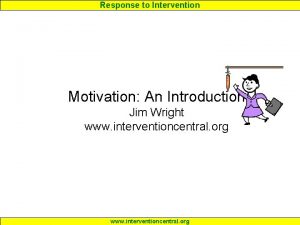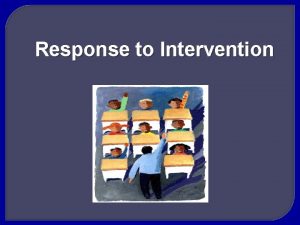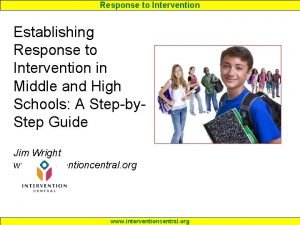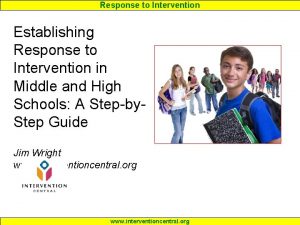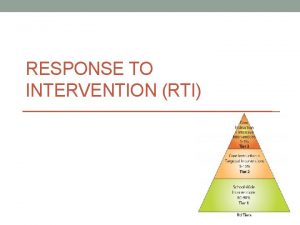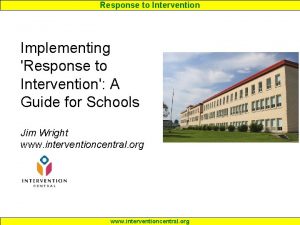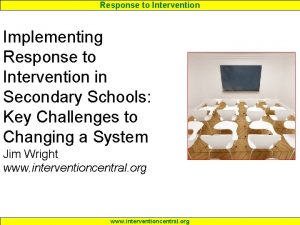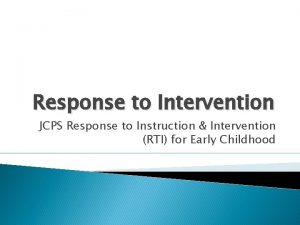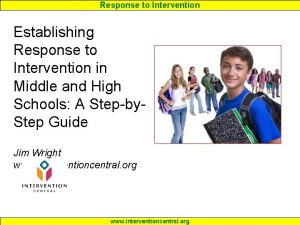Response to Intervention Assessing Intervention Integrity Jim Wright













































































- Slides: 77

Response to Intervention Assessing Intervention Integrity Jim Wright www. interventioncentral. org

Response to Intervention Why Assess Intervention Integrity? When a struggling student fails to respond adequately to a series of evidence-based interventions, that student is likely to face significant and potentially negative consequences, such as failing grades, long-term suspension from school, or even placement in special education. It is crucial, then, that the school monitor the integrity with which educators implement each intervention plan so that it can confidently rule out poor or limited intervention implementation of the intervention as a possible explanation for www. interventioncentral. org 2

Response to Intervention Integrity Check: Direct Observation Intervention integrity is best assessed through direct observation (Roach & Elliott, 2008). – The key steps of the intervention are defined and formatted as an observational checklist. – An observer watches as the intervention is conducted and checks off on the checklist those steps that were correctly carried out. The observer then computes the percentage of steps correctly carried out. www. interventioncentral. org 3

Response to Intervention Limitations of Direct Observation as an Intervention Integrity Check • Direct observations are time-consuming to conduct. • Teachers who serve as interventionists may at least initially regard observations of their intervention implementation as evaluations of their job performance, rather than as a childfocused RTI “quality check”. • An intervention-implementation checklist typically does not distinguish between--or differentially weight--those intervention steps that are more important from those that are less so. If two teachers implement the same 10 -step intervention plan, for example, with a critical step and the in Source: one Gansle, instructor K. A. , & Noell, G. H. omitting (2007). The fundamental role of intervention implementation assessing responseomitting to intervention. In S. fairly R. Jimerson, M. K. Burns, & A. M. Van. Der. Heyden (Eds. ), other a trivial step, both can still Response to intervention: The science and practice of assessment and intervention (pp. 244 -251). attain the same implementation score of steps www. interventioncentral. org 4

Response to Intervention ‘Yes/No’ Step-by-Step Intervention Check Each Step Marked ‘Negotiable or ‘Non. Negotiable’ Intervention Script Builder www. interventioncentral. org

Response to Intervention Supplemental Methods to Collect Data About Intervention Integrity Teacher Self-Ratings: As a form of selfmonitoring, directing interventionists to rate the integrity of their own interventions may prompt higher rates of compliance (e. g. , Kazdin, 1989). However, because teacher self-ratings tend to be ‘upwardly biased (Gansle & Noell, 2007, p. 247), they should not be relied upon as the sole rating of intervention integrity. One suggestion for collecting regular teacher reports on intervention implementation in a convenient manner is to use Daily Behavior Reports (DBRs; Chafouleas, Riley-Tillman, , & Sources: Chafouleas, S. , Riley-Tillman, T. C. , & Sugai, G. (2007). School-based behavioral assessment: Informing Sugai, 2007). intervention and instruction. New York: Guilford Press. Gansle, K. A. , & Noell, G. H. (2007). The fundamental role of intervention implementation in assessing response to intervention. In S. R. Jimerson, M. K. Burns, & A. M. Van. Der. Heyden (Eds. ), Response to intervention: The science and practice of assessment and intervention (pp. 244 -251). Kazdin, A. E. (1989). Behavior modification in applied settings (4 th ed. ). Pacific Gove, CA: Brooks/Cole. . www. interventioncentral. org 6

Response to Intervention Teacher Intervention Integrity Self. Rating Intervention Contact Log www. interventioncentral. org 7

Response to Intervention Supplemental Methods to Collect Data About Intervention Integrity Intervention Permanent Products: If an intervention plan naturally yields permanent products (e. g. , completed scoring sheets, lists of spelling words mastered, behavioral sticker charts), these products can be periodically collected and evaluated as another indicator of intervention integrity (Gansle Source: Noell, 2007). Gansle, & K. A. , & Noell, G. H. (2007). The fundamental role of intervention implementation in assessing response to intervention. In S. R. Jimerson, M. K. Burns, & A. M. Van. Der. Heyden (Eds. ), Response to intervention: The science and practice of assessment and intervention (pp. 244 -251). www. interventioncentral. org 8

Response to Intervention Integrity: Verify Through a Mix of Information Sources Schools should consider monitoring intervention integrity through a mix of direct and indirect means, including direct observation and permanent products (Gansle & Noell, 2007), as well as interventionist selfratings (Roach & Elliott, 2008). Source: Gansle, K. A. , & Noell, G. H. (2007). The fundamental role of intervention implementation in assessing response to intervention. In S. R. Jimerson, M. K. Burns, & A. M. Van. Der. Heyden (Eds. ), Response to intervention: The science and practice of assessment and intervention (pp. 244 -251). Roach, A. T. , & Elliott, S. N. (2008). Best practices in facilitating and evaluating intervention integrity. In A. Thomas & J. Grimes (Eds. ), Best practices in school psychology V (pp. 195 -208). www. interventioncentral. org 9

Response to Intervention ‘Selecting Methods to Track Intervention Integrity’… www. interventioncentral. org 10

Response to Intervention ‘Selecting Methods to Track Intervention Integrity’… www. interventioncentral. org 11

Response to Intervention ‘Selecting Methods to Track Intervention Integrity’… www. interventioncentral. org 12

Response to Intervention ‘Selecting Methods to Track Intervention Integrity’… www. interventioncentral. org 13

Response to Intervention Team Activity: Measuring ‘Intervention Follow. Through’ At your table: • Brainstorm ways that your RTI Team will use to measure intervention integrity for academic interventions. • What preparations are necessary to introduce these methods for measuring ‘intervention followthrough’ to your faculty? www. interventioncentral. org 14

Response to Intervention Academic Interventions ‘Critical Components’ Checklist www. interventioncentral. org

Response to Intervention Academic Interventions ‘Critical Components’ Checklist www. interventioncentral. org 16

Response to Intervention Academic Interventions ‘Critical Components’ Checklist This checklist summarizes the essential components of academic interventions. When preparing a student’s Tier 1, 2, or 3 academic intervention plan, use this document as a ‘pre -flight checklist’ to ensure that the academic intervention is of high quality, is sufficiently strong to address the identified student problem, is fully understood and supported by the teacher, and can be implemented with integrity. NOTE: While the checklist refers to the ‘teacher’ as the interventionist, it can also be used as a guide to ensure the quality of interventions implemented by nonwww. interventioncentral. org 17

Response to Intervention Allocating Sufficient Contact Time & Assuring Appropriate Student-Teacher Ratio The cumulative time set aside for an intervention and the amount of direct teacher contact are two factors that help to determine that intervention’s ‘strength’ (Yeaton & Sechrest, 1981). Critical Item? Intervention Element Time Allocated. The time set aside for the intervention is appropriate for the type and level of student problem (Burns & Gibbons, 2008; Kratochwill, Clements & Kalymon, 2007). When evaluating whether the amount of time allocated is adequate, consider: Length of each intervention session. Frequency of sessions (e. g. . , daily, 3 times per week) Duration of intervention period (e. g. , 6 instructional weeks) Student-Teacher Ratio. The student receives sufficient contact from the teacher or other person delivering the intervention to make that intervention effective. NOTE: Generally, www. interventioncentral. org Notes

Response to Intervention Matching the Intervention to the Student Problem Academic interventions are not selected at random. First, the student academic problem(s) is defined clearly and in detail. Then, the likely explanations for the academic problem(s) are identified to understand which intervention(s) are likely to help—and which should be avoided. Critical Item? Intervention Element Notes Problem Definition. The student academic problem(s) to be addressed in the intervention are defined in clear, specific, measureable terms (Bergan, 1995; Witt, Van. Der. Heyden & Gilbertson, 2004). The full problem definition describes: Conditions. Describe the environmental conditions or task demands in place when the academic problem is observed. Problem Description. Describe the actual observable academic behavior in which the student is engaged. Include rate, accuracy, or other quantitative information of student performance. Typical or Expected Level of Performance. Provide a typical or expected performance criterion for this skill or behavior. Typical or expected academic performance can be calculated using a variety of sources, www. interventioncentral. org

Response to Intervention www. interventioncentral. org 20

Response to Intervention Matching the Intervention to the Student Problem (Cont. ) Critical Item? Intervention Element Notes Appropriate Target. Selected intervention(s) are appropriate for the identified student problem(s) (Burns, Van. Der. Heyden & Boice, 2008). TIP: Use the Instructional Hierarchy (Haring et al. , 1978) to select academic interventions according to the four stages of learning: Acquisition. The student has begun to learn how to complete the target skill correctly but is not yet accurate in the skill. Interventions should improve accuracy. Fluency. The student is able to complete the target skill accurately but works slowly. Interventions should increase the student’s speed of responding (fluency) as well as to maintain accuracy. Generalization. The student may have acquired the target skill but does not typically use it in the full range of appropriate situations or settings. Or the student may confuse the target skill with ‘similar’ skills. Interventions should get the student to use the skill in the widest possible range of settings and situations, or to accurately discriminate between the target skill and ‘similar’ skills. Adaptation. The student is not yet able to modify or adapt an existing skill to fit novel task-demands or situations. Interventions should help the student to identify key concepts or elements from previously learned skills that can be adapted to the new demands or situations. www. interventioncentral. org

Response to Intervention Matching the Intervention to the Student Problem (Cont. ) Critical Item? Intervention Element ‘Can’t Do/Won’t Do’ Check. The teacher has determined whether the student problem is primarily a skill or knowledge deficit (‘can’t do’) or whether student motivation plays a main or supporting role in academic underperformance (‘wont do’). If motivation appears to be a significant factor contributing to the problem, the intervention plan includes strategies to engage the student (e. g. , high interest learning activities; rewards/incentives; increased student choice in academic assignments, etc. ) (Skinner, Pappas & Davis, 2005; Witt, Van. Der. Heyden & Gilbertson, 2004). www. interventioncentral. org Notes

Response to Intervention Activity: Matching the Intervention to the Student Problem • Consider these critical aspects of academic intervention: q Clear and specific problem-identification statement (Conditions, Problem Description, Typical/Expected Level of Performance). q Appropriate intervention target (e. g. , selected intervention is appropriately matched to Acquisition, Fluency, Generalization, or Adaptation phase of Instructional Hierarchy). q Can’t Do/Won’t Do Check (Clarification of whether motivation plays a significant role in student academic underperformance). www. interventioncentral. org

to Intervention Incorporating Effective. Response Instructional Elements These effective ‘building blocks’ of instruction are well-known and well-supported by the research. They should be considered when selecting or creating any academic intervention. Critical Item? Intervention Element Explicit Instruction. Student skills have been broken down “into manageable and deliberately sequenced steps” and the teacher provided“ overt strategies for students to learn and practice new skills” (Burns, Van. Der. Heyden & Boice, 2008, p. 1153). Appropriate Level of Challenge. The student experienced sufficient success in the academic task(s) to shape learning in the desired direction as well as to maintain student motivation (Burns, Van. Der. Heyden & Boice, 2008). Active Engagement. The intervention ensures that the student is engaged in ‘active accurate responding’ (Skinner, Pappas & Davis, 2005). at a rate frequent enough to capture student attention and to optimize effective learning. Performance Feedback. The student receives prompt performance feedback about the work completed (Burns, Van. Der. Heyden & Boice, 2008). Maintenance of Academic Standards. If the intervention includes any accommodations to better support the struggling learner (e. g. , preferential seating, breaking a longer assignment into smaller chunks), those accommodations do not substantially lower the academic standards against www. interventioncentral. org which the student is to be evaluated and are not likely to reduce the student’s Notes

Response to Intervention Activity: Incorporating Effective Instructional Elements • Think about the effective instructional elements reviewed in this workshop. • Incorporating Effective How can your school assist. Instructional Elements Critical teachers to ensure that Item? effective instructional elements are included in academic interventions? Intervention Element Explicit Instruction. Appropriate Level of Challenge. Active Engagement. . Performance Feedback. Maintenance of Academic Standards. www. interventioncentral. org Notes

Response to Intervention Verifying Teacher Understanding & Providing Teacher Support The teacher is an active agent in the intervention, with primary responsibility for putting it into practice in a busy classroom. It is important, then, that the teacher fully understands how to do the intervention, believes that he or she can do it, and knows whom to seek out if there are problems with the intervention. Critical Item? Intervention Element Notes Teacher Responsibility. The teacher understands his or her responsibility to implement the academic intervention(s) with integrity. Teacher Acceptability. The teacher states that he or she finds the academic intervention feasible and acceptable for the identified student problem. Step-by-Step Intervention Script. The essential steps of the intervention are written as an ‘intervention script’--a series of clearly described steps—to ensure teacher understanding and make implementation easier (Hawkins, Morrison, Musti-Rao & Hawkins, 2008). Intervention Training. If the teacher requires training to carry out the intervention, that training has been arranged. Intervention Elements: Negotiable vs. Non-Negotiable. The teacher knows all of the steps of the intervention. Additionally, the teacher knows which of the intervention steps are ‘non-negotiable’ (they must be completed exactly as designed) and which are ‘negotiable’ (the teacher has some latitude in how to carry out those steps) (Hawkins, Morrison, Musti-Rao & Hawkins, 2008). www. interventioncentral. org

Response to Intervention Activity: Verifying Teacher Understanding & Providing Teacher Support In your teams: • Review the checklist for verifying that teachers understand all elements of the intervention and actively support its use. Verifying Teacher Understanding & Providing • How will your school ensure Critical Item? Support Intervention Element Teacher that teachers in Tier 1 will Teacher Responsibility Teacher Acceptability. understand support Step-by-Step Intervention academic interventions Script. Intervention Training. designed to be implemented in Intervention Elements: the classroom? Negotiable vs. Nonwww. interventioncentral. org

Response Intervention Documenting the Intervention &to. Collecting Data Interventions only have meaning if they are done within a larger data-based context. For example, interventions that lack baseline data, goal(s) for improvement, and a progressmonitoring plan are ‘fatally flawed’ (Witt, Van. Der. Heyden & Gilbertson, 2004). Critical Item? Intervention Element Notes Intervention Documentation. The teacher understands and can manage all documentation required for this intervention (e. g. , maintaining a log of intervention sessions, etc. ). Checkup Date. Before the intervention begins, a future checkup date is selected to review the intervention to determine if it is successful. Time elapsing between the start of the intervention and the checkup date should be short enough to allow a timely review of the intervention but long enough to give the school sufficient time to judge with confidence whether the intervention worked. Baseline. Before the intervention begins, the teacher has collected information about the student’s baseline level of performance in the identified area(s) of academic concern (Witt, Van. Der. Heyden & Gilbertson, 2004). Goal. Before the intervention begins, the teacher has set a specific goal for predicted student improvement to use as a minimum standard for success (Witt, Van. Der. Heyden & Gilbertson, 2004). The goal is the expected student outcome by the checkup date if the intervention is successful. Progress-Monitoring. During the intervention, the teacher collects progressmonitoring data of sufficient quality and at a sufficient frequency to determine at www. interventioncentral. org

Response to Intervention Activity: Documenting the Intervention & Collecting Data In your teams: • Consider the elements of intervention documentation, data collection, and data interpretation discussed here. • Documenting the Intervention What steps can your school &take Collecting Data to make sure that data have Critical a Item? central focus when interventions are planned and implemented? Intervention Element Intervention Documentation. Checkup Date. Baseline. Goal. www. interventioncentral. org Notes

Response to Intervention References • • • Bergan, J. R. (1995). Evolution of a problem-solving model of consultation. Journal of Educational and Psychological Consultation, 6(2), 111 -123. Burns, M. K. , & Gibbons, K. A. (2008). Implementing response-to-intervention in elementary and secondary schools. Routledge: New York. Burns, M. K. , Van. Der. Heyden, A. M. , & Boice, C. H. (2008). Best practices in intensive academic interventions. In A. Thomas & J. Grimes (Eds. ), Best practices in school psychology V (pp. 11511162). Bethesda, MD: National Association of School Psychologists. Haring, N. G. , Lovitt, T. C. , Eaton, M. D. , & Hansen, C. L. (1978). The fourth R: Research in the classroom. Columbus, OH: Charles E. Merrill Publishing Co. Hawkins, R. O. , Morrison, J. Q. , Musti-Rao, S. , & Hawkins, J. A. (2008). Treatment integrity for academic interventions in real- world settings. School Psychology Forum, 2(3), 1 -15. Kratochwill, T. R. , Clements, M. A. , & Kalymon, K. M. (2007). Response to intervention: Conceptual and methodological issues in implementation. In Jimerson, S. R. , Burns, M. K. , & Van. Der. Heyden, A. M. (Eds. ), Handbook of response to intervention: The science and practice of assessment and intervention. New York: Springer. Skinner, C. H. , Pappas, D. N. , & Davis, K. A. (2005). Enhancing academic engagement: Providing opportunities for responding and influencing students to choose to respond. Psychology in the Schools, 42, 389 -403. Witt, J. C. , Van. Der. Heyden, A. M. , & Gilbertson, D. (2004). Troubleshooting behavioral interventions. A systematic process for finding and eliminating problems. School Psychology Review, 33, 363 -383. Yeaton, W. M. & Sechrest, L. (1981). Critical dimensions in the choice and maintenance of www. interventioncentral. org 30

Response to Intervention Implementing Response to Intervention: Key Challenges to Changing a System Jim Wright www. interventioncentral. org

Response to Intervention “ Tipping point: “any process in which, beyond a certain point, the rate at which the process increases dramatically. ” (Tipping Point, 2010). ” Source: Tipping point (sociology). (2010, February 17). In Wikipedia, The Free Encyclopedia. Retrieved 02: 52, March 1, 2010, from http: //en. wikipedia. org/w/index. php? title=Tipping_point_(sociology)&oldid=344548179 www. interventioncentral. org 32

Response to Intervention “ “The tipping point is the moment of critical mass, the threshold, the boiling point. ” (Gladwell, 2000; p. 12) ” Source: Gladwell, M. (2000). The tipping point: How little things can make a big difference. Little, Brown and Company: NY. www. interventioncentral. org 33

Response to Intervention RTI: Research Questions Q: What Conditions Support the Successful Implementation of RTI? RTI requires: • Continuing professional development to give teachers the skills to implement RTI and educate new staff because of personnel turnover. • Administrators who assert leadership under RTI, including setting staff expectations for RTI implementation, finding the needed resources, and monitor ingthe fidelity of implementation. • Proactive hiring of teachers who support the principles of RTI and have the skills to put RTI into practice in the classroom. • The changing of job roles of teachers and support staff (school psychologists, reading specialists, special educators, etc. ) to support the RTI model. • Input from teachers and support staff (‘bottom-up’) about how to make RTI work in the school or district, as well as guidance from Source: Fuchs, D. , & Deshler, D. D. (2007). What we need to know about responsiveness to intervention administration (‘top-down’). (and shouldn’t be afraid to ask). . Learning Disabilities Research & Practice, 22(2), 129– 136. www. interventioncentral. org 34

Response to Intervention Preventing Your School from Developing ‘RTI Antibodies’ • Schools can anticipate and take steps to address challenges to RTI implementation in schools • This proactive stance toward RTI adoption will reduce the probability that the ‘host’ school or district will reject RTI as a model www. interventioncentral. org 35

Response to Intervention ‘Scaling Up’: Four Stages of RTI Development Jim Wright www. interventioncentral. org

Response to Intervention RTI Development: Four Stages of ‘Scaling Up’ 1. Preparation. Planning activities & creating readiness in the school system for the RTI component. 2. Initial Implementation. Bringing the component into the school setting. 3. Institutionalization. Institutionalizing the RTI component as a part of routine school and district practices. 4. Ongoing Development/Updating. Ensuring that the RTI component stays current with changing revisions in state and federal Source: guidelines Ervin, R. A. , & Schaughency, E. (2008). Best practices in accessing the. RTI systems change and emerging findings in literature. In A. Thomas & J. Grimes (Eds. ), Best practices in school psychology V (pp. 853 -873). Bethesda, MD: National Association of School Psychologists. research. www. interventioncentral. org 37

Response to Intervention www. interventioncentral. org 38

Response to Intervention RTI Implementation Planning Sheet: Example “GOAL: Creating Consistent Use of Effective Tier 1 Academic Strategies in Content-Area Classrooms” Stage 1: Preparation: List any preparation steps such as development of materials or staff training. Examples of Preparation Tasks: § Inventory Tier 1 Interventions Already in Use § Create a Standard Menu of Evidence. Based Tier 1 Intervention Ideas for Teachers www. interventioncentral. org 39

Response to Intervention Sheet: RTI Implementation Planning Example “GOAL: Creating Consistent Use of Effective Tier 1 Academic Strategies in Content-Area Classrooms” Stage 2: Initial Implementation: Describe the tasks required to actually implement the goal. Examples of Initial Implementation Tasks: § Train Teachers to Write Specific, Measureable, Observable ‘Problem Identification Statements § Establish Tier 1 Coaching and Support Resources § Provide Classroom (Tier 1) Problem. Solving Support to Teachers www. interventioncentral. org 40

RTI Implementation Planning Response to Intervention Sheet: Example “GOAL: Creating Consistent Use of Effective Tier 1 Academic Strategies in Content-Area Classrooms” Stage 3: Institutionalization: Once the goal is initially carried out successfully, devise a plan to weave various activities that support the goal into the day-to-day institutional routine of the school. Examples of Institutionalization Tasks: § Develop Decision Rules for Referring Students from Tier 1 to Higher Levels of Intervention www. interventioncentral. org 41

RTI Implementation Planning Response to Intervention Sheet: Example “GOAL: Creating Consistent Use of Effective Tier 1 Academic Strategies in Content-Area Classrooms” Stage 4: Ongoing Development/Updating: The RTI model is steadily evolving as new research indicates better methods for data collection, intervention planning, etc. The RTI Implementation Plan should include Ongoing Development/Updating tasks-ongoing activities to ensure that the district’s practices confirm to best practices over time. Examples of Ongoing Development/Updating Tasks: § Set Up a System to Locate Additional Evidencewww. interventioncentral. org Based Tier 1 Intervention Ideas 42

Response to Intervention RTI Steering Committee: Using the Four Stages of ‘Scaling Up’ in Planning • First, the RTI Steering Committee selects a series of ‘RTI Implementation Goals. ’ These goals should be more general, global goals that will require attention through all stages of the RTI implementation process. • The RTI Steering Committee then takes each of the general RTI Implementation Goals and breaks the global goal into a series of specific subtasks. Subtasks are sorted by stage of implementation. www. interventioncentral. org 43

Response to Interventionist, Consultant, Data Analyst: Shared Job Descriptions Under RTI Jim Wright www. interventioncentral. org

Response to Intervention Shared Roles: Interventionist The interventionist is a teacher or other educator who is directly responsible for implementing an intervention for an individual student or small group. The role requires clear definition of the student problem(s), selection of evidence-based intervention strategies or programs, use of data to determine if the intervention is effective, and measurement of how the intervention is carried out to ensure that www. interventioncentral. org 45

Response to Interventionist: Key ‘Look-Fors’ 1. Defines the student academic or behavioral concern in clear, specific, measurable terms. 2. Selects interventions that are ‘evidence-based’ (i. e. , intervention practices or programs that have been demonstrated to be effective in one or more highquality studies in reputable peer reviewed journals). 3. Selects interventions that logically match the presenting student problem(s) (e. g. , choosing a fluency-building intervention such as Paired Reading for a student who has acquired basic reading skills but has delayed reading fluency). www. interventioncentral. org 46

Response to Interventionist: Key ‘Look-Fors’ 4. Delivers the intervention with a high level of integrity (e. g. , ensuring that the intervention is implemented with the appropriate frequency, session length, steps of the intervention, student-teacher group size, etc. ). 5. Ensures that any accommodations included as part of a general-education student’s RTI intervention plan (e. g. , preferential seating, breaking a longer assignment into smaller chunks) do not substantially lower the academic standards against which the student is to be evaluated and are not likely to reduce the student’s rate of learning. 6. Knows which elements of the intervention are ‘critical’ (must be implemented precisely as designed) and those that are ‘negotiable’ (the interventionist has some degree of flexibility in how those elements are implemented). www. interventioncentral. org 47

Response to Interventionist: Key ‘Look-Fors’ 7. Completes required documentation of the intervention (e. g. , writing down all necessary details of the intervention plan before implementing, maintaining a contact log to record each intervention session, etc. ). 8. Collects baseline data on student performance prior to the intervention, sets a predicted goal for student improvement to be attained by the intervention checkup date, and allots an adequate minimum period for the intervention (e. g. , 4 -8 instructional weeks) to adequately judge its impact. 9. Collects regular progress-monitoring data during the intervention to determine if the student is making adequate progress (Tier 1 monitoring frequency is at discretion of the interventionist; Tier 2 monitoring occurs at least 1 -2 times per month; Tier 3 monitoring occurs at least weekly). 10. Applies decision rules at the checkup date to evaluate whether www. interventioncentral. org 48

Response to Intervention Shared Roles: Consultant The consultant provides support to teachers (or other interventionists), helping them to structure and implement an intervention to maximize its chances for success. The consultant establishes a collegial relationship with teachers, uses a structured problem-solving model to match students to those intervention ideas most likely to be effective, and focuses on student factors that are alterable as the focus of www. interventioncentral. org 49

Response to Intervention Consultant: Key ‘Look-Fors’ 1. Has knowledge within his or her area(s) of expertise of a range of intervention ideas that are ‘evidence-based’. 2. Fosters collegial relationships to promote teachers’ willingness to access consultation services. For example, the consultant uses ‘safe’ language in consultation that avoids the appearance of ‘judging’ teachers’ skills or job performance— concentrating instead on objective data and actual student performance. 3. Focuses during the consultation meeting on those factors that are alterable in a school setting (e. g. , instructional materials, instructional strategies, motivating strategies). www. interventioncentral. org 50

Response to Intervention Consultant: Key ‘Look-Fors’ 4. Ensures that a range of possible factors are considered to increase the probability of finding the correct explanation of a student’s academic, behavioral, or other problems. A helpful acronym to promote investigation of multiple possible explanations of student problems in schools is ICEL: instruction (factors related to instructional delivery); curriculum (degree of student master of curriculum goals); environment (non-instructional factors in the learning environment such as presence of peers that can help or impede learning); learner (factors residing primarily within the learner—such as high levels of inattention across all classes or a low sense of selfefficacy regarding school-- that can significantly influence learning ). www. interventioncentral. org 51

Response to Intervention Consultant: Key ‘Look-Fors’ 5. Follows a structured problem-solving agenda during consultation meetings. The initial consultation meeting includes (a) problem identification, (b) problem analysis, and(c) development of an intervention plan. The follow-up consultation meeting includes (c) an evaluation of the effectiveness of the intervention plan. 6. Helps teachers to define student academic and behavioral problems in clear, specific, measureable terms. 7. Ensures that interventions developed in consultation meetings are scripted in step-by-step format with sufficient detail to promote teachers’ high-quality implementation. www. interventioncentral. org 52

Response to Intervention Consultant: Key ‘Look-Fors’ 8. Assists teachers in measuring student baseline performance and in computing goals for student progress. 9. Develops a plan with teacher input to measure the integrity with which the intervention is implemented using a mix of direct and indirect means (e. g. , sampling of student work products produced during the intervention; teacher self-ratings of intervention integrity; direct observation of intervention implementation). NOTE: The teacher is also strongly encouraged to notify the consultant immediately if any part of the intervention cannot be carried out as designed. 10. Schedules a follow-up meeting with the teacher (e. g. , 4 -8 instructional weeks after the initial consultation meeting) to determine whether the intervention plan is successful and to decide on the next step(s) to be taken. www. interventioncentral. org 53

Response to Intervention Shared Roles: Data Analyst The data analyst makes an effort to help the teacher or school to collect information from a variety of sources to better understand a student problem, creates time-series graphs as visual displays to show student progress, finds the best methods for estimating peer performance and setting goals for rate of student progress, and can apply tools of data analysis to progress-monitoring data to determine if the student has www. interventioncentral. org 54

Response to Intervention Data Analyst: Key ‘Look-Fors’ 1. Ensures that background information is drawn from varied data sources to more fully understand a presenting student academic or behavioral problem. A helpful acronym to promote collection of multiple kinds of data in schools is RIOT: review of student records; interviews; observations of the student, testing. 2. Can judge when sufficient data have been collected from multiple sources to allow the teacher or school to analyze the student problem (‘data saturation’ point). 3. Uses time-series (progress-monitoring) graphs to convert student baseline and progress-monitoring numeric data into visual displays of data points that are easy to interpret. www. interventioncentral. org 55

Response to Intervention Data Analyst: Key ‘Look-Fors’ 4. Selects the most appropriate method to estimate typical or expected peer performance in a particular academic or other targeted skill. The data analyst selects from among these possible options: research norms/performance benchmarks/product norms, schoolwide norms, classroom or small group norms, expert opinion. 5. Calculates predicted rate of student progress during the intervention using the most appropriate method. The data analyst selects from among these possible choices: research growth norms, product growth norms, average rates of student progress calculated from schoolwide screenings repeated several times during the school year, expert opinion. 6. Helps teachers to sift through multiple types of available classroom data and determine the relative value for each in providing clear, objective, ‘low-inference’ information about the www. interventioncentral. org presenting student problem(s). 56

Response to Intervention Data Analyst: Key ‘Look-Fors’ 7. Assists in developing plans for teachers to measure student progress during interventions—using classroom data that is feasible to collect (e. g. , direct observation; student work products; teacher ratings; student self-ratings; grades and other archival information). 8. Observes the general principle that methods of student assessment and progress-monitoring should have technical adequacy (validity and reliability) sufficient for the task. The data analyst understands that interventions at earlier tiers such as Tier 1 with lower stakes can use less-rigorous, classroom-friendly data, while high-stakes interventions at higher tiers such as Tier 3 will require data sources with more rigorous technical adequacy. www. interventioncentral. org 57

Response to Intervention Data Analyst: Key ‘Look-Fors’ 9. Uses a range of tools to analyze student baseline and progress-monitoring data formatively to determine whether the intervention is successful. Some examples of data-analysis tools are visual analysis of charted data across intervention phases, trend lines, and percentage of non-overlapping data points. 10. Applies standard data-based decision rules adopted by the school or district to determine whether a student is making adequate progress with the existing intervention, requires an intervention change, or should be referred to a higher Tier for additional intervention support. www. interventioncentral. org 58

Response to Intervention Team Activity: Planning RTI ‘Next Steps’… At your table: • Select up to 5 ‘next steps’ for moving forward with RTI at your school. • Use the organizer forms (4 stages of implementation: p. 22; next steps form: p. 23) to help you in your planning. • Be prepared to report out on your progress. www. interventioncentral. org 59

Response to Intervention Methods of Classroom Data Collection Jim Wright www. interventioncentral. org

Response to Intervention RTI ‘Pyramid of Interventions’ Tier 3 Tier 2 Tier 1 Tier 3: Intensive interventions. Students who are ‘non-responders’ to Tiers 1 & 2 are referred to the RTI Team for more intensive interventions. Tier 2 Individualized interventions. Subset of students receive interventions targeting specific needs. Tier 1: Universal interventions. Available to all students in a classroom or school. Can consist of whole-group or individual www. interventioncentral. org 61

Response to Interventions: Potential ‘Fatal Flaws’ Any intervention must include 4 essential elements. The absence of any one of the elements would be considered a ‘fatal flaw’ (Witt, Van. Der. Heyden & Gilbertson, 2004) that blocks the school from drawing meaningful conclusions from the student’s response to the intervention: 1. Clearly defined problem. The student’s target concern is stated in specific, observable, measureable terms. This ‘problem identification statement’ is the most important step of the problem-solving model (Bergan, 1995), as a clearly defined problem allows the teacher or RTI Team to select a wellmatched intervention to address it. 2. Baseline data. The teacher or RTI Team measures the student’s academic skills in the target concern (e. g. , reading fluency, math computation) prior to beginning the intervention. Baseline data becomes the point of comparison throughout the intervention to help the school to determine whether that intervention is effective. 3. Performance goal. The teacher or RTI Team sets a specific, data-based goal for student improvement during the intervention and a checkpoint date by which the goal should be attained. 4. Progress-monitoring plan. The teacher or RTI Team collects student data Source: Witt, J. to C. , determine Van. Der. Heyden, A. M. , & Gilbertson, D. (2004). Troubleshooting behavioral regularly whether the student is on-track to reach the interventions. A systematic performance goal. process for finding and eliminating problems. School Psychology Review, 33, 363 -383. www. interventioncentral. org 62

Response to Intervention www. interventioncentral. org 63

Response to Intervention Existing Records • Description: The teacher uses information already being collected in the classroom that is relevant to the identified student problem. • Examples of existing records that can be used to track student problems include: – Grades – Absences and incidents of tardiness – Homework turned in www. interventioncentral. org 64

Response to Intervention Skills Checklists • Description: The teacher selects a global skill. The teacher then breaks that global skill down into specific, observable ‘subskills’. Each subskill can be verified as ‘done’ or ‘not done’. www. interventioncentral. org 65

Response to Intervention Skills Checklists: Example • The teacher selects the global skill ‘organizational skills’. • That global skill is defined as having the following components, each of which can be observed: qarriving to class on time; qbringing work materials to class; qfollowing teacher directions in a timely manner; qknowing how to request teacher assistance when needed; qhaving an uncluttered desk with only www. interventioncentral. org 66

Response to Intervention Behavioral Frequency Count • Description: The teacher observes a student behavior and keeps a cumulative tally of the number of times that the behavior is observed during a given period. • Behaviors that are best measured using frequency counts have clearly observable beginning and end points—and are of relatively short duration. Examples include: – Student call-outs. – Requests for teacher help during independent seatwork. – Raising one’s hand to make a contribution www. interventioncentral. org to large-group discussion. 67

Response to Intervention Behavioral Frequency Count: How to Record Teachers can collect data on the frequency of student behaviors in several ways: • Keeping a mental tally of the frequency of target behaviors occurring during a class period. • Recording behaviors on paper (e. g. , simple tally marks) as they occur. • Using a golf counter, stitch counter, or other mechanical counter device to www. interventioncentral. org 68

Response to Intervention Behavioral Frequency Count: How to Compute • If student behaviors are being tallied during a class period, frequency-count data can be reported as ‘X number of behaviors per class period’. • If frequency-count data is collected in different spans of time on different days, however, schools can use the following method to standardize frequency count data : – Record the total number of behaviors observed. – Record the number of minutes in the observation period. – Divide the total number of behaviors observed by total minutes in the observation period. Example: 5 callouts observed during a 10 www. interventioncentral. org 69

Response to Intervention Behavior Log • Description: The teacher makes a log entry each time that a behavior is observed. An advantage of behavior logs is that they can provide information about the context within which a behavior occurs. (Disciplinary office referrals are a specialized example of a behavior log. ) • Behavior logs are useful for tracking ‘low-incidence’ problem behaviors. www. interventioncentral. org 70

Response to Intervention Behavior Log: Sample Form www. interventioncentral. org 71

Response to Intervention Rating Scales • Description: A scale is developed that a rater can use to complete a global rating of a behavior. Often the rating scale is completed at the conclusion of a fixed observation period (e. g. , after each class period). • Daily / Direct Behavior Report Cards are one example of rating scales. www. interventioncentral. org 72

Response to Intervention Student Work Samples • Description: Work samples are collected for information about the student’s basic academic skills, mastery of course content, etc. • Recommendation: When collecting work samples: – Record the date that the sample was collected – If the work sample was produced in class, note the amount of time needed to complete the sample (students can calculate and record this information). www. interventioncentral. org 73

Response to Intervention Work Performance Logs • Description: Information about student academic performance is collected to provide insight into growth in student skills or use of skills in appropriate situations. Example: A teacher implementing a vocabulary-building intervention keeps a cumulative log noting date and vocabulary words mastered. • Example: A student keeps a journal with www. interventioncentral. org 74

Response to Intervention Timed Tasks (e. g. , Curriculum-Based Measurement) • Description: The teacher administers structured, timed tasks to assess student accuracy and fluency. • Example: The student completes a 2 minute CBM single-skill math computation probe. • Example: The student completes a 3 minute CBM writing probe that is scored for total words written. www. interventioncentral. org 75

Response to Intervention Combining Classroom Monitoring Methods • Often, methods of classroom data collection and progress-monitoring can be combined to track a single student problem. • Example: A teacher can use a rubric (checklist) to rate the quality of student work samples. • Example: A teacher may keep a running tally (behavioral frequency count) of student callouts. At the same time, the www. interventioncentral. org 76

Response to Intervention Activity: Classroom Methods of Data Collection In your teams: • Review the potential sources of classroom data Classroom Data that can be used to monitor Sources: Tier 1 interventions. • Existing records • Skills checklist • What questions do you have about any of these • Rating scales data sources? • Behavioral frequency count • How can your school make full use of these data • Behavioral log sources to ensure that • Student work samples every Tier 1 intervention is • Work performance logs www. interventioncentral. org
 Jim wright intervention central
Jim wright intervention central Writing interventions
Writing interventions Jim wright rti
Jim wright rti Jim wright oma
Jim wright oma Rti checklist
Rti checklist Ncrti
Ncrti Simplifying response to intervention
Simplifying response to intervention Response to intervention pyramid
Response to intervention pyramid National center for response to intervention
National center for response to intervention Primary immune response and secondary immune response
Primary immune response and secondary immune response Natural response and forced response
Natural response and forced response Natural and forced response
Natural and forced response Ncbts and ppst differences
Ncbts and ppst differences Assessing parental capacity
Assessing parental capacity Teaching and assessing grammar in the writing classroom
Teaching and assessing grammar in the writing classroom Oecd maps
Oecd maps Cultural dynamics in assessing global markets
Cultural dynamics in assessing global markets Assessing the internal environment of the firm
Assessing the internal environment of the firm Assessing the situation
Assessing the situation Many new drivers first fender bender is a backing collision
Many new drivers first fender bender is a backing collision Task analysis in hrd
Task analysis in hrd Group discussion
Group discussion Assessing reading multiple measures
Assessing reading multiple measures Assessing health status chapter 22
Assessing health status chapter 22 Assessing a new venture's financial strength and viability
Assessing a new venture's financial strength and viability Assessing hrd needs
Assessing hrd needs Cultural dynamics in assessing global markets
Cultural dynamics in assessing global markets Btec sport unit 3
Btec sport unit 3 Module 4 topic 1 assessing and managing risk
Module 4 topic 1 assessing and managing risk Assessing strengths and weaknesses
Assessing strengths and weaknesses Dominant work values in today's workforce
Dominant work values in today's workforce Inherent risk
Inherent risk Assessing motivation to change
Assessing motivation to change Assessing cardiorespiratory fitness
Assessing cardiorespiratory fitness Assessing value for money
Assessing value for money Unit 18 assessing children's development support needs
Unit 18 assessing children's development support needs A nine box matrix requires assessing employees on ________.
A nine box matrix requires assessing employees on ________. Manual for assessing safety hardware
Manual for assessing safety hardware Cultural dynamics in assessing global markets
Cultural dynamics in assessing global markets Amc math assessment
Amc math assessment Assessing opportunity cost involves
Assessing opportunity cost involves Assessing leadership and measuring its effects
Assessing leadership and measuring its effects Mark r. wright
Mark r. wright Louis t. wright
Louis t. wright The magic box poem
The magic box poem Erik olin wright sınıf kuramı
Erik olin wright sınıf kuramı Diana browning wright
Diana browning wright Judith wright magpies
Judith wright magpies Praxinoscope adalah
Praxinoscope adalah Will wright
Will wright Maria wright edelman
Maria wright edelman Daine wright
Daine wright Morgan wright minnesota
Morgan wright minnesota Dr paula wright
Dr paula wright Antonio iglesias gamarra
Antonio iglesias gamarra Lymphocytes normal range
Lymphocytes normal range Nordics region
Nordics region Stufen der partizipation wright
Stufen der partizipation wright Coombs'lu wright testi
Coombs'lu wright testi Frank lloyd wright apush
Frank lloyd wright apush Robert s wright
Robert s wright Lewisham borough of culture
Lewisham borough of culture Sistema arquitravat
Sistema arquitravat Wright brothers engine
Wright brothers engine House palate classification
House palate classification Wright county soccer
Wright county soccer C wright mills
C wright mills Oração de joe wright
Oração de joe wright Where did the propellers sit on the wright flyer?
Where did the propellers sit on the wright flyer? Richard wright sfu
Richard wright sfu C wright mills conflict theory
C wright mills conflict theory Manoeuvre de cozen
Manoeuvre de cozen Wright's stain procedure
Wright's stain procedure Andrew wright teacher
Andrew wright teacher Wendy wright amherst nh
Wendy wright amherst nh Chris wright red hat
Chris wright red hat Lovett muscle test
Lovett muscle test Morgan vaughan
Morgan vaughan
